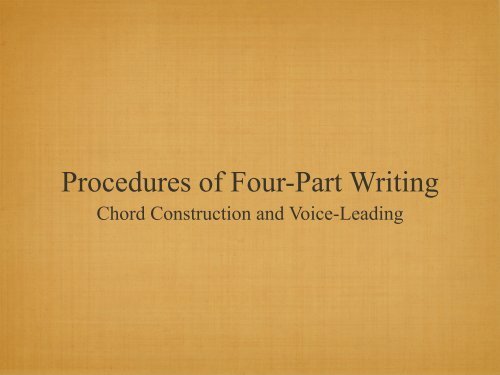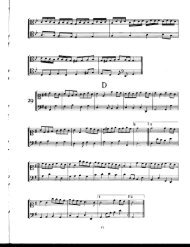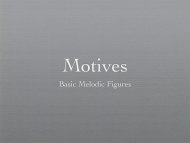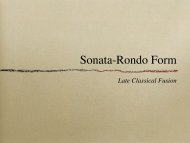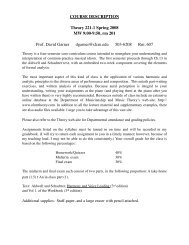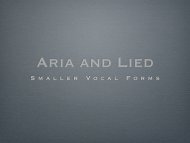Procedures of Four-Part Writing - SFCMTheory
Procedures of Four-Part Writing - SFCMTheory
Procedures of Four-Part Writing - SFCMTheory
You also want an ePaper? Increase the reach of your titles
YUMPU automatically turns print PDFs into web optimized ePapers that Google loves.
<strong>Procedures</strong> <strong>of</strong> <strong>Four</strong>-<strong>Part</strong> <strong>Writing</strong><br />
Chord Construction and Voice-Leading
<strong>Four</strong> Voices<br />
Soprano<br />
Alto<br />
Tenor<br />
Bass<br />
Soprano Alto Tenor Bass
Notation Style
Notation Style<br />
<br />
<br />
<br />
<br />
<br />
<br />
<br />
<br />
<br />
<br />
<br />
<br />
Soprano and alto in the treble clef
Notation Style<br />
<br />
<br />
<br />
<br />
<br />
<br />
<br />
<br />
<br />
<br />
<br />
<br />
Soprano and alto in the treble clef<br />
Bass and tenor in the bass clef
Notation Style<br />
<br />
<br />
<br />
<br />
<br />
<br />
<br />
<br />
<br />
<br />
<br />
<br />
Soprano and alto in the treble clef<br />
Bass and tenor in the bass clef<br />
Stems distinguish one voice from another
Notation Style<br />
<br />
<br />
<br />
<br />
<br />
<br />
<br />
<br />
<br />
<br />
<br />
<br />
Soprano and alto in the treble clef<br />
Bass and tenor in the bass clef<br />
Stems distinguish one voice from another<br />
Note the unison on the third beat
Doubling<br />
All else being equal, it’s best to double the root<br />
However, any note <strong>of</strong> a chord may be doubled unless it is a<br />
note which requires a specific resolution, such as:<br />
The 7th <strong>of</strong> a seventh chord<br />
The leading tone
Doubling<br />
Do not think <strong>of</strong> “double the root” as a hard-and-fast rule.<br />
A progression can be vastly improved sometimes by<br />
doubling notes other than the root.
Doubling<br />
In this first example, doubling the root <strong>of</strong> the first two chords results in a parallel<br />
fifth (an illegal motion) being written between the two inner voices.<br />
<br />
<br />
<br />
<br />
<br />
<br />
<br />
<br />
<br />
<br />
<br />
<br />
<br />
In this revision, the third <strong>of</strong> each chord is doubled (between tenor and soprano in the<br />
first chord, and between bass and tenor in the second chord) and solves the problem.
Complete and Incomplete Chords<br />
Chords are complete when they contain at least one instance<br />
<strong>of</strong> each chord element (root, 3rd, 5th, etc.)<br />
Chords are incomplete when one <strong>of</strong> those elements is<br />
missing.
Incomplete Chords<br />
It is sometimes necessary to write incomplete chords to<br />
avoid problems with voice-leading.<br />
Do not write incomplete chords in inversions<br />
Generally speaking double (or triple) the root and omit<br />
the fifth <strong>of</strong> the chord<br />
Never omit the 3rd <strong>of</strong> a chord!
Spacing<br />
Do not allow more than one octave between two adjacent<br />
voices<br />
Between bass and tenor the distance may be as much as two<br />
octaves
Exercises: Tonic Triad<br />
2<br />
& 4 bbb ? 2<br />
bb b4<br />
1 2 3 4 5 6 7 8 9 10<br />
6 6$ 6 6<br />
&bb 1 2 3 4 5<br />
b<br />
? b b b<br />
˙<br />
˙ ˙<br />
˙ ˙<br />
˙<br />
˙<br />
˙ ˙ ˙ ˙ ˙ ˙ ˙ ˙ ˙ ˙ ˙ ˙ ˙<br />
˙<br />
˙<br />
˙<br />
˙<br />
˙<br />
˙<br />
˙<br />
˙<br />
˙ ˙ ˙<br />
˙<br />
˙<br />
˙<br />
˙ ˙<br />
˙<br />
˙ ˙<br />
˙<br />
˙<br />
˙<br />
˙
&<br />
4<br />
? 2<br />
bb b4<br />
Exercises: Dominant Triad<br />
6 6$ 6 6<br />
&bb 1 2 3 4 5<br />
b<br />
? b b b<br />
6$ 6<br />
&bb 1 2 3 4 5<br />
b<br />
?<br />
˙ ˙ ˙ ˙ ˙ ˙ ˙ ˙ ˙<br />
˙<br />
˙ ˙ ˙ ˙ ˙ ˙ ˙ ˙ ˙ ˙ ˙ ˙ ˙<br />
˙<br />
˙<br />
˙<br />
˙<br />
˙<br />
˙<br />
˙<br />
˙ ˙<br />
˙<br />
˙ ˙<br />
˙˙ ˙ ˙<br />
˙ ˙ ˙ ˙ ˙˙ ˙<br />
˙<br />
˙<br />
˙<br />
˙<br />
˙
? b b b<br />
Exercises: Dominant 7th Chord<br />
6$ 6<br />
&bb 1 2 3 4 5<br />
b<br />
? b b b<br />
˙<br />
˙<br />
˙<br />
˙ ˙ ˙<br />
˙ ˙<br />
˙<br />
˙ ˙<br />
˙˙ ˙ ˙<br />
˙ ˙ ˙<br />
˙<br />
˙<br />
4£ 6% 4"<br />
˙<br />
˙<br />
˙˙ ˙ ˙
Open and Close Position<br />
Open: a chord element could be placed between any two <strong>of</strong><br />
the upper three voices<br />
Close: no chord elements could be placed between any <strong>of</strong><br />
the upper three voices
Identifying Close and Open
Identifying Close and Open
Identifying Close and Open<br />
<br />
<br />
<br />
<br />
Open
Identifying Close and Open
Identifying Close and Open
Identifying Close and Open<br />
<br />
<br />
<br />
<br />
Open
Identifying Close and Open
Identifying Close and Open
Identifying Close and Open<br />
<br />
<br />
<br />
<br />
Close
Identifying Close and Open
Identifying Close and Open
Identifying Close and Open<br />
<br />
<br />
Open
Identifying Close and Open
Identifying Close and Open
Identifying Close and Open<br />
<br />
<br />
<br />
<br />
Close
Keyboard Style<br />
Comes from the old system <strong>of</strong> “realizing” a figured bass line<br />
The right hand is used to play the upper three voices, while<br />
the left hand plays the bass<br />
The upper three voices are written in the treble clef, while<br />
the bass line is written in the bass<br />
The soprano line may or may not be stemmed separately<br />
from the alto and tenor
Keyboard Style
Melodic Motion
Melodic Motion<br />
Conjunct Motion
Melodic Motion<br />
Conjunct Motion<br />
Disjunct Motion
Leaps
Leaps<br />
Small leaps (up to about a fifth) aren’t much <strong>of</strong> a problem
Leaps<br />
Small leaps (up to about a fifth) aren’t much <strong>of</strong> a problem<br />
Larger leaps need to be handled more carefully:
Leaps<br />
Small leaps (up to about a fifth) aren’t much <strong>of</strong> a problem<br />
Larger leaps need to be handled more carefully:<br />
The octave is the maximum distance
Leaps<br />
Small leaps (up to about a fifth) aren’t much <strong>of</strong> a problem<br />
Larger leaps need to be handled more carefully:<br />
The octave is the maximum distance<br />
Avoid two in a row in the same direction, unless they<br />
arpeggiate a triad (and even then be careful!)
Leaps<br />
Small leaps (up to about a fifth) aren’t much <strong>of</strong> a problem<br />
Larger leaps need to be handled more carefully:<br />
The octave is the maximum distance<br />
Avoid two in a row in the same direction, unless they<br />
arpeggiate a triad (and even then be careful!)<br />
Generally after a larger leap, return stepwise in the<br />
opposite direction whenever possible
Leaps<br />
Small leaps (up to about a fifth) aren’t much <strong>of</strong> a problem<br />
Larger leaps need to be handled more carefully:<br />
The octave is the maximum distance<br />
Avoid two in a row in the same direction, unless they<br />
arpeggiate a triad (and even then be careful!)<br />
Generally after a larger leap, return stepwise in the<br />
opposite direction whenever possible<br />
Do not allow a leap <strong>of</strong> an augmented second
Leaps<br />
<br />
<br />
These are all good
Leaps<br />
<br />
<br />
good<br />
These are leaps involving sixths and above<br />
<br />
good<br />
<br />
poor<br />
<br />
poor<br />
<br />
<br />
<br />
good<br />
<br />
<br />
poor<br />
<br />
<br />
forbidden
Leaps<br />
<br />
<br />
poor<br />
Multiple leaps, some good, some not<br />
<br />
<br />
good<br />
<br />
good<br />
<br />
good
Simultaneous Motion
Simultaneous Motion<br />
Parallel Motion<br />
Both voices move in the same direction and retain the<br />
same interval between them
Simultaneous Motion<br />
Parallel Motion<br />
Both voices move in the same direction and retain the<br />
same interval between them<br />
Similar Motion<br />
Both voices move in the same direction, but the interval<br />
between them changes
Simultaneous Motion<br />
Parallel Motion<br />
Both voices move in the same direction and retain the<br />
same interval between them<br />
Similar Motion<br />
Both voices move in the same direction, but the interval<br />
between them changes<br />
Oblique Motion<br />
Only one voice moves while the other remains stationary
Simultaneous Motion<br />
Parallel Motion<br />
Both voices move in the same direction and retain the<br />
same interval between them<br />
Similar Motion<br />
Both voices move in the same direction, but the interval<br />
between them changes<br />
Oblique Motion<br />
Only one voice moves while the other remains stationary<br />
Contrary Motion<br />
The voices move in opposite directions
Simultaneous Motion
Simultaneous Motion
Simultaneous Motion<br />
<br />
Similar
Simultaneous Motion
Simultaneous Motion
Simultaneous Motion<br />
<br />
<br />
<br />
Contrary
Simultaneous Motion
Simultaneous Motion
Simultaneous Motion<br />
<br />
Parallel
Simultaneous Motion
Simultaneous Motion
Simultaneous Motion<br />
<br />
Oblique
Simultaneous Motion
Simultaneous Motion
Simultaneous Motion<br />
<br />
Parallel
Simultaneous Motion
Simultaneous Motion
Simultaneous Motion<br />
<br />
Contrary
Simultaneous Motion
Simultaneous Motion
Simultaneous Motion<br />
<br />
<br />
<br />
Trick Question! No motion at all
Simultaneous Motion
Simultaneous Motion
Simultaneous Motion<br />
<br />
Oblique
Simultaneous Motion
Simultaneous Motion
Simultaneous Motion<br />
<br />
<br />
<br />
Contrary
Simultaneous Motion
Simultaneous Motion
Simultaneous Motion<br />
<br />
Similar
Forbidden Parallel Motions
Forbidden Parallel Motions<br />
Motion by octaves
Forbidden Parallel Motions<br />
Motion by octaves<br />
Motion by unisons
Forbidden Parallel Motions<br />
Motion by octaves<br />
Motion by unisons<br />
Motion by fifths
Forbidden Contrary Motions
Forbidden Contrary Motions<br />
Octaves
Forbidden Contrary Motions<br />
Octaves<br />
<br />
Fifths
Hidden (Direct) Motions
Hidden (Direct) Motions<br />
Fifths
Hidden (Direct) Motions<br />
Fifths<br />
<br />
Octaves
Hidden (Direct) Motions
Hidden (Direct) Motions<br />
Hidden, or direct, motion is a problem only if:
Hidden (Direct) Motions<br />
Hidden, or direct, motion is a problem only if:<br />
1. It occurs between the outer voices AND
Hidden (Direct) Motions<br />
Hidden, or direct, motion is a problem only if:<br />
1. It occurs between the outer voices AND<br />
2. The soprano is moving by leap
Hidden (Direct) Motions<br />
Hidden, or direct, motion is a problem only if:<br />
1. It occurs between the outer voices AND<br />
2. The soprano is moving by leap<br />
Otherwise, don’t worry about it
Voice Crossing
Voice Crossing<br />
Forbidden for now
Overlapping
Overlapping<br />
Forbidden for now
Practice<br />
The following progression contains many mistakes <strong>of</strong> chord<br />
construction and voice-leading. Find as many as you can.<br />
Hint: there are at least 23 errors!
Practice<br />
The following progression contains many mistakes <strong>of</strong> chord<br />
construction and voice-leading. Find as many as you can.<br />
Hint: there are at least 23 errors!
Parallel octaves between soprano and bass
Doubled leading tone between bass and soprano
Incomplete chord: no 3rd
Parallel fifths between soprano and bass
Hidden octave between soprano and bass
Parallel unison between tenor and alto
Hidden octave between bass and soprano
Overlap between alto and soprano
Spacing error between tenor and alto
Parallel fifth between bass and alto
Parallel fifth between bass and alto
Improperly incomplete chord: no 3rd
Parallel fifths between tenor and alto
Parallel octaves between bass and soprano
Fifths by contrary motion between bass and tenor
Voice crossing between tenor and alto
Voice crossing between tenor and alto
Parallel fifths between bass and tenor
Doubled leading tone in tenor and soprano
Voice crossing between tenor and alto
Parallel octaves between alto and bass
Voice crossing between tenor and alto
Incomplete chord: no 3rd


